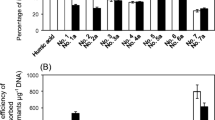Abstract
A technique of potential use to the biotechnology industry was developed for studying the survival of bacteria in aqueous extracts of soil. The aqueous extracts of soil were placed into test tubes, amended as desired, inoculated with bacteria containing recombinant DNA, and incubated. Most bacteria introduced into filter-sterilized soil extracts were capable of multiplying and maintained populations of 10 E6 to 10 E8 cfu/ml over 13 days. However, bacteria introduced into nonsterile soil extracts at 10 E5 cfu/ml were found to decrease by 2–3 logs over a 13-day period. The soil extract method revealed that recombinant DNA plasmids had no significant effect on survival of thePseudomonas spp. andEscherichia coli strains examined. Extracts from soil provide a convenient and homogeneous milieu for estimating relative competitiveness and documenting survival characteristics of genetically engineered microorganisms. The use of aqueous extracts of soil offer convenience, a means of obtaining homogeneous cell suspensions, and ease of experimental replication over the inoculation of bacteria uniformly into soil.
Similar content being viewed by others
Literature Cited
American Society for Testing and Materials (1982) CO2 evolution coulometric titration method In: Standard methods for carbon dioxide and bicarbonate and carbonate ions in water. Philadelphia: American Society for Testing and Materials.
Gause G (1934) The struggle for existence. New York: Dover
Liang LN, Sinclair J, Mallory L, Alexander M (1982) Fate in model ecosystems of microbial species of potential use in genetic engineering. Appl Environ Microbiol 44:708–714
Maniatis T, Fritsch EF, Sambrook J (1982) Molecular cloning, a laboratory manual. Cold Spring Harbor NY: Cold Spring Harbor Laboratory, p 69
Milewski EA (1985) Field testing microorganisms modified by recombinant DNA techniques: applications, issues, and development of “points to consider document”. Recomb DNA Tech Bull 8:102–108
Reanney DC, Gowland PC, Slater HJ (1983) Genetic interactions among microbial communities. In: Slater JH, Whittenbury R, Wimpenny WT (eds) Microbes in their natural environment: 34th symposium of the Society for General Microbiology. New York: Cambridge University Press, pp 379–411
Rissler JF (1984) Research needs for biotic environmental effects of genetically engineered microorganisms. Recomb DNA Tech Bull 7:20–30
Sinclair JL, Alexander M (1984) Role of resistance to starvation in bacterial survival in sewage and lake water. Appl Environ Microbiol 48:410–415
Swift MJ (1982) Microbial succession during the decay of organic matter. In: Burns RG, Slater JH (eds) Experimental microbial ecology. Oxford: Blackwell, pp 164–177
Weisberg S (1985) Applied linear regression. New York: Wiley and Sons, pp 169–185
Author information
Authors and Affiliations
Rights and permissions
About this article
Cite this article
Walter, M.V., Barbour, K., McDowell, M. et al. A method to evaluate survival of genetically engineered bacteria in soil extracts. Current Microbiology 15, 193–197 (1987). https://doi.org/10.1007/BF01577529
Issue Date:
DOI: https://doi.org/10.1007/BF01577529




